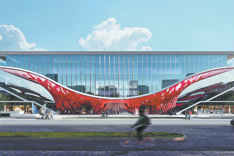Areas in Shanghai ready to embrace post-lockdown life

Shanghai residents in communities at low risk for COVID-19 can move freely in the city except in areas deemed at medium or high risk for the virus starting on Wednesday, the Shanghai government announced on Monday.
Public transportation in the city will also resume full operations on Wednesday, along with taxis and vehicles engaged in online hailing services. Private cars from low-risk areas can also hit the road, the city government said.
The changes are in line with the city's overall plan to resume normal production and order in the city, which has been under epidemic control measures since April.
"The epidemic in the city has been effectively brought under control and the situation continues to improve," the city government said.
It urged residents to maintain personal protection and hygiene habits, strengthen self-monitoring and refrain from gathering in groups. Residents were also encouraged to get COVID-19 vaccinations and collaborate with epidemic prevention and control measures at public venues to safeguard the city.
Shanghai reported 65 new COVID-19 infections on Sunday, the municipal government said on Monday. This is the first time in two months that the daily tally of new infections in the city is below the 100 mark.
Zhao Dandan, deputy director of the Shanghai Health Commission, said in a news briefing on Monday that Shanghai has set up 15,000 nucleic acid test stations in preparation for the planned return to normalcy in the city on June 1.
Four thousand of the stations are located inside residential compounds, 6,000 in companies, schools and construction sites, and 5,000 in public areas. Some test stations have already started operations.
Separately, Beijing reported 18 new locally transmitted cases as of 3 pm on Monday, bringing the total number of infections to 1,752 since April 22, said Liu Xiaofeng, deputy director of the Beijing Center for Disease Prevention and Control.
China's capital still faces risks of infection as one new locally transmitted case was reported at the community level on Monday. Aside from that one case in a Fengtai district community, all of the remaining 17 cases were reported in quarantined locations.
The city had not reported new local cases at the community level for three consecutive days before Monday. The new case showed the risk of infection still exists, Xu Hejian, spokesman for the Beijing government, said at a news conference on Monday.
Fast action urged
"We should ensure both economic operation and epidemic control and prevention work," he said. "The authority should take faster action and stricter measures to prevent the virus from spreading."
Of the 1,752 cases since April 22, Chaoyang district reported 424, the most in the outbreak. Due to swift and strict measures, Chaoyang has not reported any community-level cases in the past seven days.
Except for people in locked-down and controlled zones, Chaoyang residents can return to workplaces and major shopping malls can gradually resume operations, said Yang Beibei, deputy head of the district, on Monday.
As of Monday, Beijing had four COVID-19 high-risk areas and 14 medium-risk areas.

Today's Top News
- Importance of work related to agriculture, rural areas and farmers categorically clear: China Daily editorial
- Drills to help secessionists see reason: China Daily editorial
- SOEs post stable revenue, profits in Jan-Nov
- First brew in Lhasa
- PLA fully capable of crushing secessionist attempts
- China holds central rural work conference






























